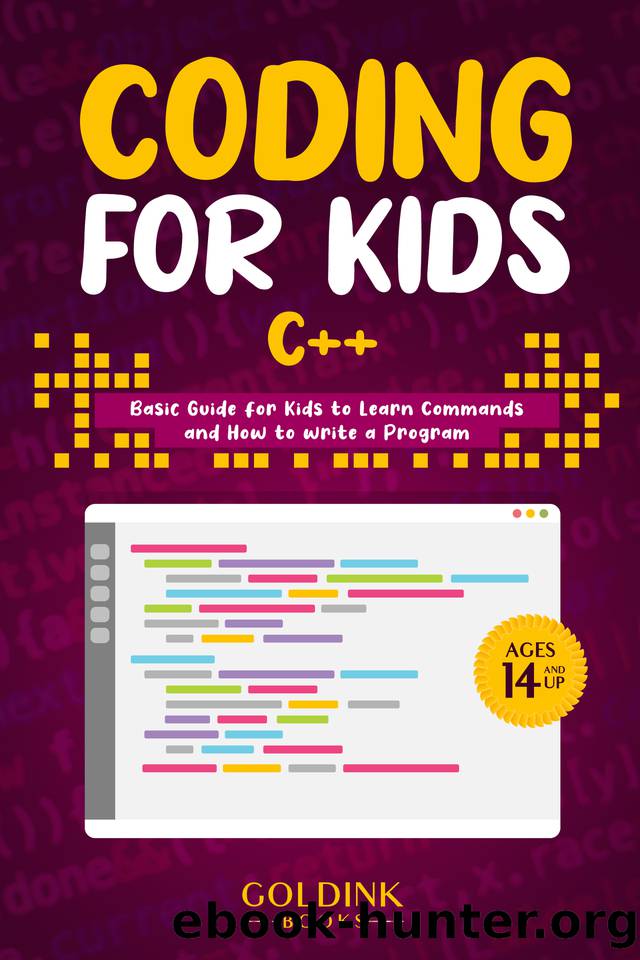Coding for Kids C++: Basic Guide for Kids to Learn Commands and How to Write a Program by Books GoldInk

Author:Books, GoldInk [Books, GoldInk]
Language: eng
Format: epub
Published: 2021-10-01T00:00:00+00:00
4.1 Introduction to Array
In C++, an array is a collection of comparable data types such as int, char, float, double, and others that are stored using the index value and can be accessed using simply the index value. It uses a single variable to store all of the instances of variables. In C++, an array can be defined in three ways: by specifying the array's size, directly initializing array elements, or specifying the array's size with its elements.
To allow data to be handled by any application, we must first enter the data into the application. This implies that the value should be saved somewhere in the application until the program executes.
The computer language provides a variable to fulfill the function of storing values. Variables are used to store values so that the application can use them to generate the anticipated result. As values are stored in variables, they take up space in the memory allocated to the application. As a result, the best coding strategy is to ensure that the variable is used as little as feasible. The concept of the array was created to address the memory allocation issue caused by the development of a large number of variables. The array can be thought of as a collection of values of the same datatype.
How do arrays work in C++?
The following is a description of how arrays work:
â The array's purpose is to store values of the same datatype. It is designed to work in the same way as the variable, and the only advantage it has over the variable is that it may hold many values at the same time. We must provide the number of variables we wish to store in the array while creating an array in C++ or any other programming language.
â It is worth noting that the array's size remains constant during the application's lifetime and cannot be altered dynamically. Once the array's size has been determined, we can store the same number of values in it. If the array's data type is set to an integer, it will not take any values that are not integers. The index will be used to locate the value held by the array.
â For example, if the array can hold two values, the second value will be stored at the array's one position because the array's index starts with zero. We will learn how to create arrays in the future.
Download
This site does not store any files on its server. We only index and link to content provided by other sites. Please contact the content providers to delete copyright contents if any and email us, we'll remove relevant links or contents immediately.
| C | C++ |
| Tutorials | Visual C++ |
Hello! Python by Anthony Briggs(10193)
The Mikado Method by Ola Ellnestam Daniel Brolund(10106)
OCA Java SE 8 Programmer I Certification Guide by Mala Gupta(10041)
Algorithms of the Intelligent Web by Haralambos Marmanis;Dmitry Babenko(8585)
Sass and Compass in Action by Wynn Netherland Nathan Weizenbaum Chris Eppstein Brandon Mathis(7965)
Grails in Action by Glen Smith Peter Ledbrook(7940)
Test-Driven iOS Development with Swift 4 by Dominik Hauser(7898)
The Well-Grounded Java Developer by Benjamin J. Evans Martijn Verburg(7836)
Windows APT Warfare by Sheng-Hao Ma(7645)
Layered Design for Ruby on Rails Applications by Vladimir Dementyev(7378)
Blueprints Visual Scripting for Unreal Engine 5 - Third Edition by Marcos Romero & Brenden Sewell(7284)
Secrets of the JavaScript Ninja by John Resig Bear Bibeault(6736)
Kotlin in Action by Dmitry Jemerov(5367)
Solidity Programming Essentials by Ritesh Modi(4462)
Hands-On Full-Stack Web Development with GraphQL and React by Sebastian Grebe(4400)
WordPress Plugin Development Cookbook by Yannick Lefebvre(4272)
Unity 3D Game Development by Anthony Davis & Travis Baptiste & Russell Craig & Ryan Stunkel(4179)
Functional Programming in JavaScript by Mantyla Dan(4166)
The Ultimate iOS Interview Playbook by Avi Tsadok(4155)
